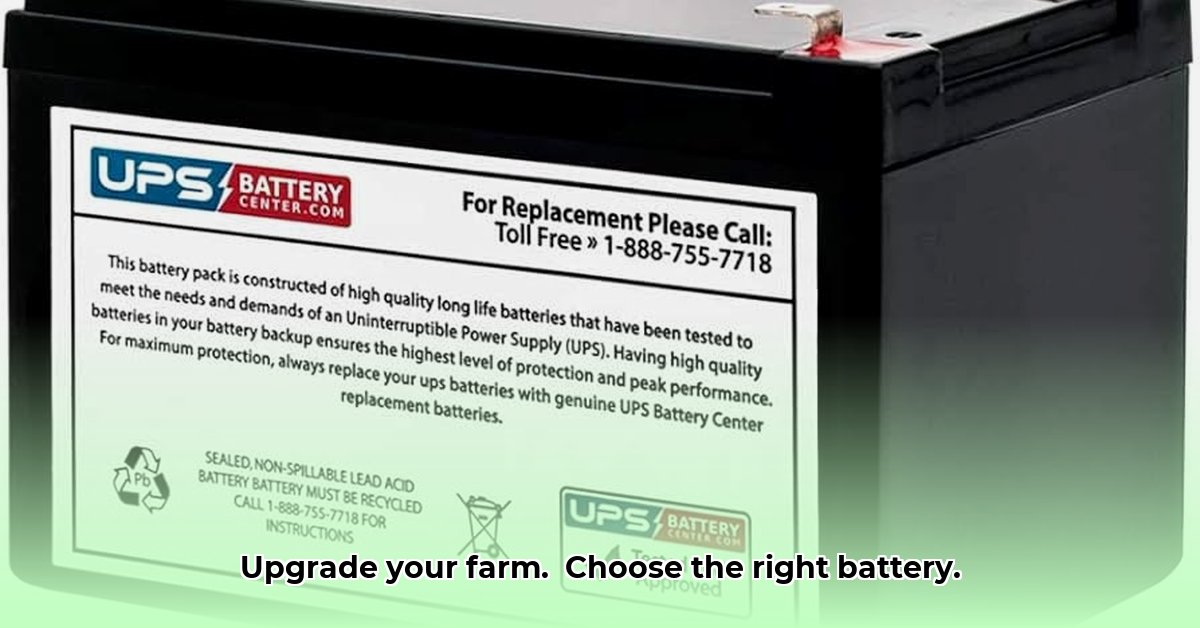
A dead tractor battery translates to lost productivity and wasted resources. This comprehensive guide empowers farmers to make informed decisions about selecting and maintaining 12-volt tractor batteries, maximizing uptime and minimizing costs. We'll explore various battery types, provide a step-by-step selection process, detail essential maintenance, and address responsible disposal. For larger tractors, consider the initial investment; see tractor pricing to plan effectively.
Understanding Your Tractor's Power Needs
Before selecting a battery, assess your tractor's power demands. Consider the tractor's size (a compact garden tractor has different needs than a large, heavy-duty model), usage frequency (daily vs. occasional use), and climate (cold weather significantly impacts starting power). These factors determine the required battery capacity and performance characteristics. A larger tractor used daily in a harsh winter environment will require a significantly more robust battery than a smaller one used infrequently in a mild climate. This assessment is vital for determining the essential Cold Cranking Amps (CCA), Amp-hours (Ah), and Reserve Capacity (RC) ratings.
Types of 12-Volt Tractor Batteries: A Detailed Comparison
Several battery chemistries are suitable for agricultural applications, each presenting unique advantages and disadvantages:
Flooded Lead-Acid (FLA): These are traditional, often less expensive batteries. However, they demand regular maintenance, including checking and replenishing the electrolyte level with distilled water. Neglecting this can lead to premature failure. (FLA batteries contain liquid electrolyte.)
Gel Cell: These sealed batteries contain a gelled electrolyte, eliminating the need for water topping. They're more resistant to vibration than FLA batteries, but generally more expensive. (Gel Cell batteries feature a gelled electrolyte, preventing spills and reducing maintenance.)
Absorbent Glass Mat (AGM): Another sealed, low-maintenance option offering superior performance and durability, particularly valuable in harsh conditions. AGM batteries are highly resistant to vibration and tilting. (AGM batteries use a fiberglass mat to absorb the electrolyte, providing superior performance and durability in demanding applications.)
Lithium-ion: These advanced batteries boast higher energy density, translating to longer lifespans, better cold-weather performance, and a lighter weight. However, they're significantly more expensive than lead-acid options and require specialized chargers. (Lithium-ion batteries offer superior performance in terms of power density and lifespan but are more costly.)
The table below summarizes key differences:
| Battery Type | Cold Cranking Amps (CCA) (Typical Range) | Amp-hours (Ah) (Typical Range) | Lifespan (Years) (Estimate) | Maintenance | Price Range |
|---|---|---|---|---|---|
| Flooded Lead-Acid | 600-1000 | 80-150 | 3-5 | High | Low |
| Gel Cell | 650-900 | 100-180 | 4-6 | Low | Medium |
| AGM | 700-1200 | 120-200 | 5-7 | Low | Medium-High |
| Lithium-ion | 800-1500+ | 150-300+ | 7-10+ | Very Low | High-Very High |
Note: CCA and Ah ratings vary depending on the manufacturer and specific model. These values provide a general comparison.
Choosing the Right 12-Volt Tractor Battery: A Step-by-Step Guide
Consult your tractor's manual: This is the first and most important step. The manual specifies recommended battery type, CCA, Ah, and group size.
Assess your usage: Consider tractor size, usage frequency, and climate. This helps determine the necessary battery capacity. Isn't it interesting how different climates demand different battery characteristics?
Understand key specifications:
Cold Cranking Amps (CCA): The amount of current delivered at 0°F (-18°C) for 30 seconds while maintaining at least 1.2 volts per cell. Higher is better for cold starts.
Amp-hours (Ah): The battery's capacity to supply power over time. Higher Ah ratings indicate longer run times.
Reserve Capacity (RC): The time (in minutes) a fully charged battery can supply a 25-amp load before voltage drops.
Calculate Total Cost of Ownership (TCO): Factor in the initial purchase price, maintenance costs, and expected lifespan. A higher upfront cost for a longer-lasting battery may be more economical long-term.
12-Volt Tractor Battery Maintenance and Care: Maximizing Lifespan
Regular maintenance significantly extends battery life. Key actions include:
Keeping terminals clean: Corrosion hinders current flow. Regularly clean terminals with a wire brush and baking soda solution.
Monitoring electrolyte levels (FLA batteries only): Add distilled water to maintain the correct level.
Correct charging: Use a smart charger to prevent overcharging or undercharging.
Proper storage: If storing the battery for a long period, store it in a cool, dry place and charge it periodically.
Responsible Disposal and Recycling: Environmental Stewardship
Proper disposal is crucial. Most auto parts stores and municipalities offer recycling programs for lead-acid batteries. Locate and utilize your local recycling options to minimize environmental impact.
Cost Considerations: Balancing Initial Investment and Long-Term Savings
While initial costs vary, consider the TCO. A more expensive, longer-lasting battery can prove more economical in the long run due to reduced replacement frequency and decreased downtime.
By following this guide, farmers can make informed battery choices, enhancing farm efficiency and promoting sustainable agricultural practices.